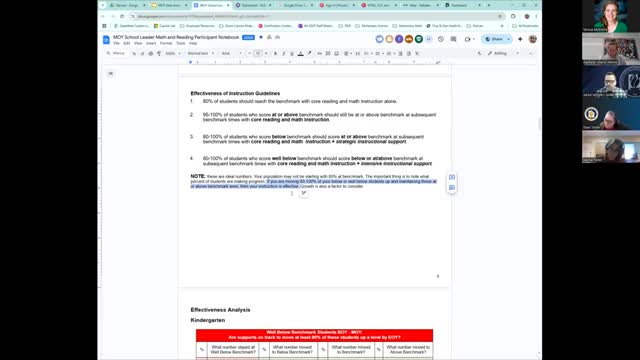District educators assess student progress through new instructional support data system
February 01, 2025 | Utah State Board of Education, Utah Government Divisions, Utah Legislative Branch, Utah
This article was created by AI summarizing key points discussed. AI makes mistakes, so for full details and context, please refer to the video of the full meeting. Please report any errors so we can fix them. Report an error »

During a recent meeting focused on Acadience Middle of Year (MOY) data analysis, Utah school leaders discussed strategies to enhance student performance in reading and math. The primary goal emphasized was the importance of moving a significant majority of students up levels to ensure their success in future benchmarks.
Key insights revealed that ideally, 80% of students should reach benchmark levels through core instruction alone. However, if this is not being achieved, educators are encouraged to consider adjustments to their instructional methods to better meet the needs of the entire class, rather than relying solely on small group interventions. The data presented showed promising results, with 95% to 100% of students maintaining or improving their scores from the beginning to the middle of the academic year.
The meeting also highlighted the importance of tracking student progress, particularly for those who are below or well below benchmark levels. The leaders noted that while the ultimate goal is for all students to reach or exceed benchmarks, any upward movement in skill levels is a positive sign of growth.
Participants were guided through the data reporting system, which allows educators to analyze student performance across different cohorts. This system provides a visual representation of how students transition between performance categories, helping educators identify areas needing attention. For instance, a cohort of 149 students who were categorized as well below benchmark at the beginning of the year showed varying degrees of progress by the middle of the year, with some moving up to below benchmark, at benchmark, or even above benchmark.
The discussion also touched on the differences in progress monitoring between reading and math, noting that while progress monitoring is essential for reading, it is optional for math. This distinction raises questions about the consistency of instructional support across subjects.
As the meeting concluded, school leaders were encouraged to delve deeper into the data and utilize the insights gained to inform their instructional strategies moving forward. The emphasis on data-driven decision-making aims to foster an educational environment where all students can thrive, ultimately benefiting the broader community by enhancing educational outcomes.
Key insights revealed that ideally, 80% of students should reach benchmark levels through core instruction alone. However, if this is not being achieved, educators are encouraged to consider adjustments to their instructional methods to better meet the needs of the entire class, rather than relying solely on small group interventions. The data presented showed promising results, with 95% to 100% of students maintaining or improving their scores from the beginning to the middle of the academic year.
The meeting also highlighted the importance of tracking student progress, particularly for those who are below or well below benchmark levels. The leaders noted that while the ultimate goal is for all students to reach or exceed benchmarks, any upward movement in skill levels is a positive sign of growth.
Participants were guided through the data reporting system, which allows educators to analyze student performance across different cohorts. This system provides a visual representation of how students transition between performance categories, helping educators identify areas needing attention. For instance, a cohort of 149 students who were categorized as well below benchmark at the beginning of the year showed varying degrees of progress by the middle of the year, with some moving up to below benchmark, at benchmark, or even above benchmark.
The discussion also touched on the differences in progress monitoring between reading and math, noting that while progress monitoring is essential for reading, it is optional for math. This distinction raises questions about the consistency of instructional support across subjects.
As the meeting concluded, school leaders were encouraged to delve deeper into the data and utilize the insights gained to inform their instructional strategies moving forward. The emphasis on data-driven decision-making aims to foster an educational environment where all students can thrive, ultimately benefiting the broader community by enhancing educational outcomes.
View full meeting
This article is based on a recent meeting—watch the full video and explore the complete transcript for deeper insights into the discussion.
View full meeting

